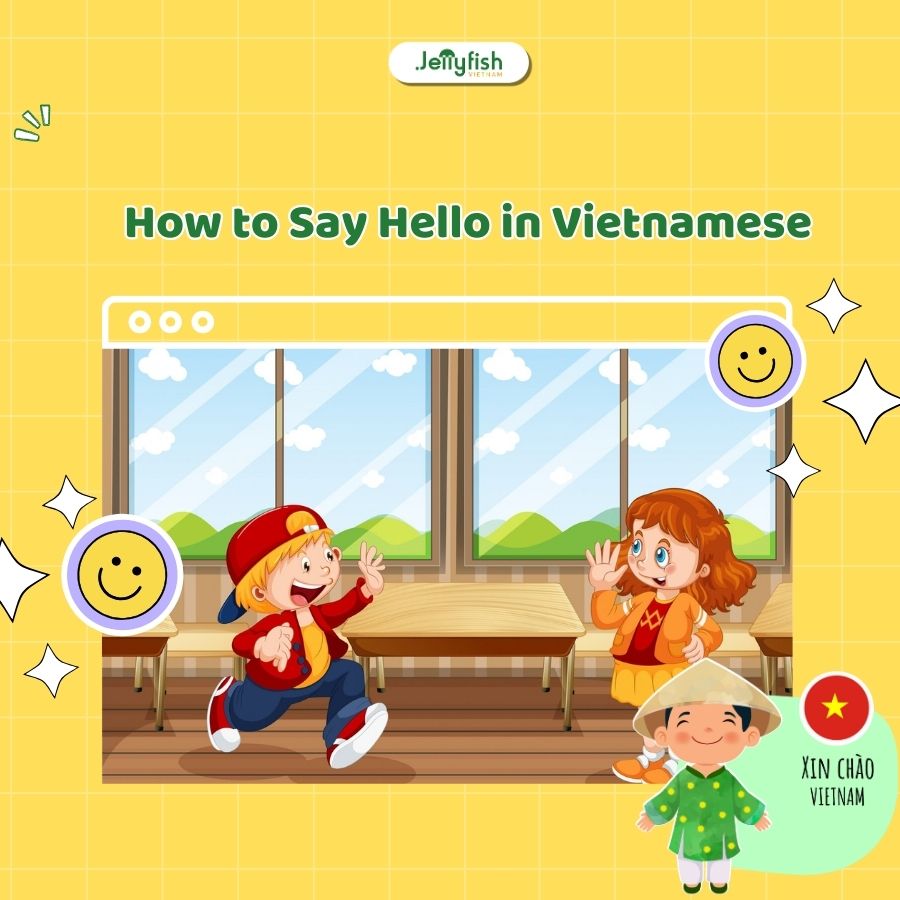Learning to greet someone properly is a fundamental step in mastering any language. In Vietnamese, the word “hello” isn’t just one fixed phrase; it depends on who you’re speaking to, where you are, and how formal the setting is. In this guide, Jellyfish shows you how to say hello in Vietnamese the right way, including polite greetings, casual phrases, and tips for different regions of Vietnam.
1. The standard way to say hello in Vietnamese
Xin chào
This is the most general and polite way to say “hello” in Vietnamese. It can be used with people of all ages and in both formal and informal settings.
Examples:
- Xin chào! → Hello!
- Xin chào anh/chị! → Hello, sir/miss!
- Xin chào các bạn! → Hello, everyone!
Note: To sound more natural, native speakers often use pronouns instead of “xin chào” alone more on that below!
2. Greeting with respect using pronouns
One of the most important aspects of how to say hello in Vietnamese is using the correct personal pronoun, based on age and relationship.
Here’s how it works:
| Pronoun | Meaning | Use when greeting |
| Anh | Older male (20s–40s) | Chào anh |
| Chị | Older female (20s–40s) | Chào chị |
| Em | Younger person | Chào em |
| Cô | Older woman / female teacher | Chào cô |
| Chú | Older man (uncle) | Chào chú |
| Bác | Elderly person | Chào bác |
| Bạn | Friend/peer | Chào bạn |
3. Casual ways to say hello in Vietnamese
When greeting friends or peers, you can use simpler and more casual expressions.
- Chào bạn! → Hello, friend!
- Chào cậu! → Hi (friendly, informal)
- Ê / Này → Hey! (used between close friends only)
- Dạo này thế nào rồi? → How’s it going?
These forms are common among students, co-workers, or people your age.
4. Regional differences in Vietnamese greetings
Vietnam has three main dialects: northern, central, and southern, and the way people say hello can vary slightly:
Northern (Hanoi):
- Xin chào anh ạ!
- Very polite, often adds “ạ” for respect.
Southern (Ho Chi Minh City):
- Chào anh ha!
- More relaxed, warm, and friendly tone.
Central (Hue):
- Dạ chào anh ạ!
- Often combines “dạ” and “ạ” for extra politeness.
When traveling or moving between regions, listening to locals helps you adjust your tone and phrasing.
5. Greeting in different situations
Knowing how to say hello in Vietnamese means knowing when and how to adapt your greeting based on context:
At work or school:
- Chào thầy/cô! → Hello, teacher!
- Chào sếp! → Hello, boss!
- Xin chào mọi người! → Hello, everyone!

Say em chào thầy/cô ạ với thầy cô ở trường học
Meeting someone for the first time:
- Xin chào, tôi tên là… → Hello, my name is…
- Rất vui được gặp bạn. → Nice to meet you.
Phone or video call:
- Alo! → Hello? (when answering the phone)
- Chào anh, em gọi từ công ty… → Hello, I’m calling from…
6. How to respond to hello in Vietnamese
Just like in English, it’s polite to respond with a greeting when someone says hello.
Example responses:
- Chào anh ạ! → Hello, sir!
- Chào bạn, lâu quá không gặp! → Hi, long time no see!
- Vâng, em chào anh! → Yes, hello sir! (adds politeness)
7. Summary table: how to say hello in Vietnamese
| Vietnamese Greeting | Meaning | Use Case |
| Xin chào | Hello (general) | Polite, any age |
| Chào anh/chị/em | Hello (with pronoun) | Age/respect-based greeting |
| Chào bạn | Hello, friend | Informal or equal status |
| Ê / Này | Hey! | Close friends only |
| Xin chào mọi người | Hello everyone | Public or group setting |
| Dạ chào… | Polite regional greeting | Central region / formal use |
Understanding how to say hello in Vietnamese is about more than just vocabulary — it’s about showing respect, kindness, and cultural awareness. Whether you’re greeting an elder, chatting with a friend, or making a business call, choosing the right greeting sets the tone for a great interaction.
Learn Vietnamese Greetings and More with Jellyfish
At Jellyfish, our courses help you:
- Master polite and casual greetings in Vietnamese
- Learn correct pronunciation and body language
- Practice live with native speakers in real situations
Complete the form below and we’ll reach out soon!
👉👉 Learning Vietnamese – Jellyfish Vietnam
✦ Hotline: 096 110 6466
✦ Head office: 1st Floor, Web3 Tower Building, Alley 4 Duy Tan Street, Cau Giay District, Hanoi
✦ Branch office: Sholega building, 275 Lach Tray, Ngo Quyen, Hai Phong
✦ Head office in Japan: 4F Westhill Building, Nishigotanda 2-24-4, Shinagawa, Tokyo, Japan


